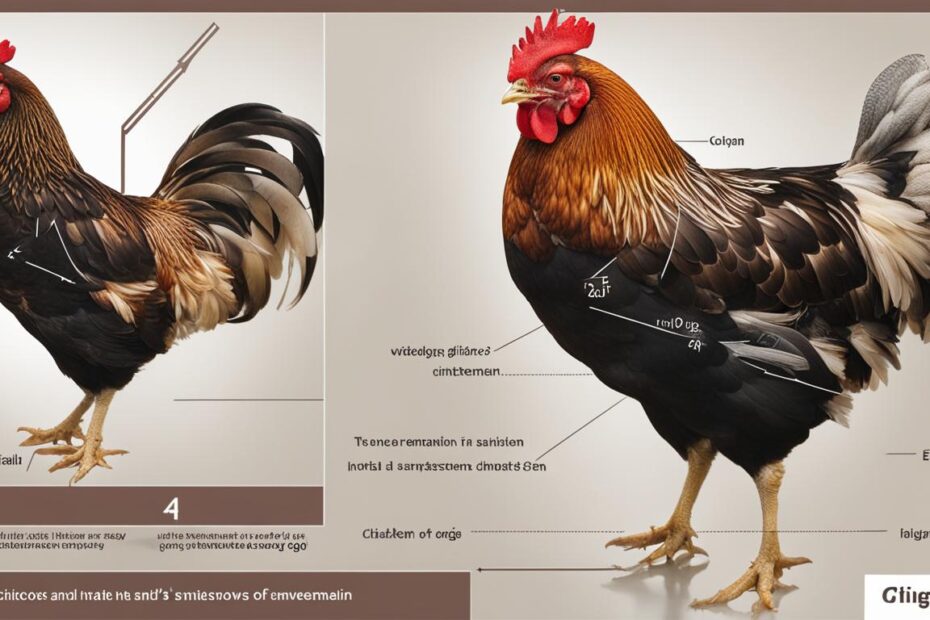When it comes to chicken anatomy, there’s one question that many people wonder about: Do chickens have butts? The answer is yes! Chickens do have an anatomical structure that corresponds to what we typically refer to as a “butt.”
The vent, also known as the cloaca, serves as both the reproductive opening and the excremental escape hatch for chickens. It is through the vent that chickens expel both feces and eggs. The vent should be pink and moist, indicating a healthy chicken. However, issues such as pasty butt can occur in chicks, causing a blockage and preventing them from passing stool. It’s important to monitor the health of a chicken’s vent to ensure their well-being.
Key Takeaways:
- Chickens do have a posterior or “butt” called the vent or cloaca.
- The vent serves as both the reproductive and excretory opening for chickens.
- Pasty butt can occur in chicks, causing a blockage and hindering stool passage.
- Monitoring the health of a chicken’s vent is essential for their well-being.
Understanding Chicken Development
Understanding the different stages of chicken development is essential for chicken owners. Whether you’re raising chickens for eggs, meat, or as pets, knowing the terminology for each stage of growth will help you properly care for your flock.
A newly hatched chicken is called a chick. These adorable little creatures require special care and attention, including warmth, proper nutrition, and protection from predators. As they grow, male chickens under a year old are referred to as cockerels, while female chickens under a year old are called pullets. Juvenile chickens can be either male or female and are simply referred to as juveniles.
Once chickens reach the age of one year, their names change based on their gender. A male chicken that is a year or older is called a cock, and a female chicken that is a year or older is called a hen. A rooster is a male chicken, which includes both cocks and cockerels. Additionally, there are certain terms used to describe specific breeds of chickens. A bantam is a small breed of chicken, while a layer breed is primarily raised for egg production. Dual-purpose breeds are raised for both eggs and meat, and ornamental breeds are raised for show or exhibition purposes. Finally, production breeds are specifically bred for high egg or meat production.
| Stage of Development | Term |
|---|---|
| Newly hatched | Chick |
| Male chicken under a year old | Cockerel |
| Female chicken under a year old | Pullet |
| Male or female juvenile | Juvenile |
| Male chicken a year or older | Cock |
| Female chicken a year or older | Hen |
| Male chicken (includes cocks and cockerels) | Rooster |
| Small breed of chicken | Bantam |
| Breed primarily raised for egg production | Layer breed |
| Breed raised for both eggs and meat | Dual-purpose breed |
| Breed raised for show or exhibition purposes | Ornamental breed |
| Breed bred for high egg or meat production | Production breed |
Understanding the different terms used to describe chickens at various stages of development will help you provide appropriate care and support the well-being of your flock.
Exploring the Chicken Environment
Creating a suitable environment for chickens is crucial for their well-being. Here are some key elements of a chicken’s environment:
- Nesting Box: A nesting box is a cubicle where chickens can privately lay eggs. It provides a comfortable and secure space for hens to lay their eggs.
- Bedding: Bedding or litter is a material used to cover the floor or ground in confined spaces. It provides comfort, absorbs moisture, and helps maintain cleanliness in the chicken coop.
- Hardware Cloth and Chicken Wire: These materials are used to contain chickens within the coop and protect them from predators. Hardware cloth is a stronger option, while chicken wire is more flexible.
- Brooder: A brooder is a heated enclosure used for raising chicks. It provides them with warmth, regulates temperature, and creates a safe space for their early development.
- Roosting: Chickens naturally roost, which means they rest on an elevated perch. Providing roosting bars or branches in the coop allows chickens to exhibit this natural behavior.
- Chicken Tractor: A chicken tractor is a movable coop without a floor. It allows chickens to have access to fresh grass, bugs, and soil while still being protected.
- Coop: A coop is an enclosure where chickens are kept safe and secure, especially during the night. It should provide adequate space, ventilation, and protection from the elements.
- Run: A run is a fenced or enclosed outdoor space for chickens to roam, scratch, and peck. It gives them access to fresh air, sunlight, and opportunities for exercise.
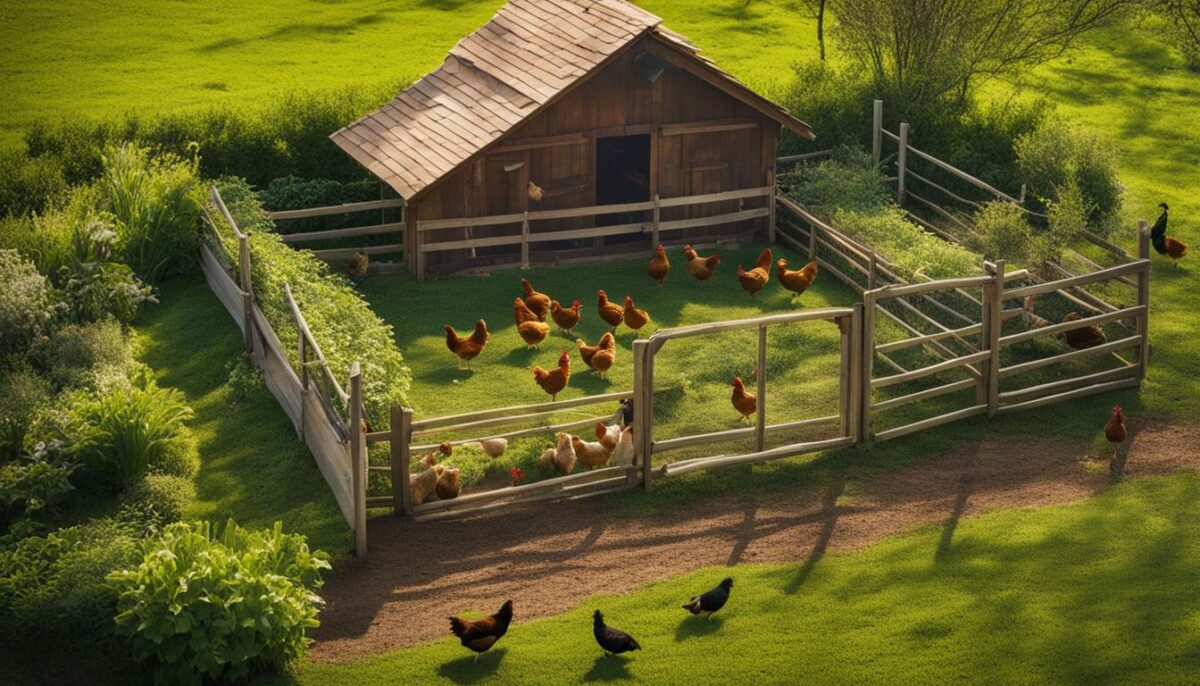
Creating a well-designed chicken environment promotes their physical and mental well-being, ensuring they can exhibit natural behaviors and live a healthy and happy life.
Table: Comparison of Different Bedding Options
| Bedding Option | Advantages | Disadvantages |
|---|---|---|
| Straw | Provides insulation, absorbs moisture well | Can harbor mites, can be dusty |
| Pine Shavings | Good odor control, readily available | Can become compacted, needs regular replacement |
| Sand | Easy to clean, doesn’t retain moisture | May require additional drainage, can cause respiratory issues if dusty |
| Wood Pellets | High absorbency, breaks down into compost | Can be more expensive, may require additional bedding material |
Choosing the right bedding option depends on factors such as availability, cost, ease of cleaning, and the specific needs of your chickens. Regular cleaning and proper maintenance of the bedding are essential for creating a clean and healthy environment for your flock.
Understanding Feather Types
Chickens have various types of feathers that serve different purposes. Let’s explore these feather types and their characteristics:
Molting:
Molting is the natural process of losing and regrowing feathers in chickens. It typically occurs during the changing seasons and helps replenish old or damaged feathers. Molting can affect a chicken’s appearance, as they may temporarily have bare patches.
Frizzle:
Frizzle is a genetic trait that results in curled or twisted feathers. This ornamental feather type gives chickens a unique and eye-catching appearance.
Down:
Down feathers are soft and fluffy and serve as insulation for young chicks. In mature chickens, down feathers are found beneath the outer feathers, providing additional warmth.
Muff:
Muff feathers refer to the short feathers located on the sides of a chicken’s face and below the chin. They give some breeds a characteristic “bearded” or fluffy appearance.
Saddle and Sickle:
Saddle feathers are located in front of the tail and can be longer and broader in male chickens. They contribute to the overall shape and appearance of the bird. Sickle feathers are the pair of long, curving feathers on a rooster’s tail, which are especially prominent in certain breeds.
Beard:
Beard feathers are elongated feathers below a chicken’s beak, giving them a puffy or “bearded” appearance. This feature is found in specific breeds.
Pin:
Pin feathers are developing feathers seen on maturing birds or after molting. These feathers have a protective sheath that eventually falls away as the feather grows and unfolds.
| Feather Type | Characteristics |
|---|---|
| Molting | Shedding and regrowth of feathers |
| Frizzle | Curled or twisted feathers |
| Down | Soft and fluffy insulation feathers |
| Muff | Short feathers on the face and below the chin |
| Saddle | Feathers in front of the tail |
| Sickle | Long and curving feathers on a rooster’s tail |
| Beard | Feathers below the beak, creating a puffy appearance |
| Pin | Developing feathers on maturing birds or after molting |
Understanding the different feather types in chickens can help chicken owners appreciate the beauty and uniqueness of these fascinating birds.
Exploring Chicken Health
Keeping chickens healthy is crucial for their well-being and productivity. There are various health issues that can affect chickens, and it’s important for chicken owners to be aware of them and take appropriate measures to prevent or treat them.
One common health issue in chicks is wry neck, a condition that causes their neck to twist and makes it difficult for them to stand. Another concern is coccidiosis, an intestinal disease caused by a parasitic organism. To prevent and treat coccidiosis, owners can use medications like amprolium specifically formulated for chicks.
External parasites, such as mites and poultry lice, can be a nuisance for chickens. Regularly inspecting chickens for signs of infestation and providing them with a dust bath can help prevent and control these pests. Additionally, chickens are susceptible to viral infections like avian influenza, fowl pox, and Newcastle disease, as well as bacterial infections like salmonella and mycoplasma. It’s essential to practice good biosecurity measures to minimize the risk of these diseases spreading.
Other health issues that can affect chickens include bumblefoot, a bacterial infection on their feet, conjunctivitis (eye infection), and paralysis. Beware of helicopter wings, broken or twisted feathers, as they can be signs of disease or sickness in chickens. Regularly observing and monitoring the health of your chickens can help identify any potential issues early on and allow for timely intervention.
Table:
| Health Issues | Treatment/Prevention |
|---|---|
| Wry Neck | Monitor and provide appropriate treatment |
| Coccidiosis | Use medications like amprolium |
| Mites and Poultry Lice | Regularly inspect chickens and provide dust bath |
| Avian Influenza, Fowl Pox, and Newcastle Disease | Practice good biosecurity measures |
| Salmonella and Mycoplasma | Ensure proper hygiene and sanitation |
| Bumblefoot | Clean and treat affected feet |
| Conjunctivitis | Provide appropriate treatment |
| Paralysis | Consult a veterinarian for diagnosis and treatment |
It’s essential for chicken owners to prioritize the health and well-being of their flock. By being vigilant and proactive in monitoring their chickens’ health, implementing appropriate preventive measures, and seeking veterinary care when necessary, owners can ensure that their chickens lead healthy and fulfilling lives.
Exploring Chicken Feed Types
Proper nutrition is crucial for the health and well-being of chickens. Understanding the different types of feed available is essential for chicken owners to ensure their flock receives the necessary nutrients at each stage of their development.
There are several types of chicken feed designed to meet specific nutritional needs:
- Starter grower feed: This feed is formulated for chicks from hatching to about 16 weeks of age. It contains a high protein content to support rapid growth and development.
- Layer feed: Layer feed is specifically formulated for hens at the laying age. It contains higher levels of calcium to support egg production. This feed is essential for hens in their egg-laying phase.
- All flock feed: This feed is suitable for mixed flocks of poultry, including chickens, ducks, and turkeys. It provides a balanced diet for all types of birds, ensuring they receive the necessary nutrients.
- Gamebird showbird feed: This feed is formulated for gamebirds, showbirds, and meatbirds that require higher protein content to promote growth and development. It is designed to support optimal performance in these types of birds.
In addition to commercial feeds, there are also supplemental options available:
- Scratch: Scratch is a mix of grains, usually including corn, and is offered as a treat to supplement a chicken’s diet. It should be given in moderation as a treat and not as a primary source of nutrition.
- Grit: Grit is small, crushed rocks or stones that chickens consume to aid in the breakdown of food in their gizzards. It helps grind and digest food, especially when chickens don’t have access to small rocks or pebbles in their natural environment.
When selecting the right feed for your chickens, it’s important to consider their age, purpose (such as egg production or meat), and any specific dietary requirements. Consulting with a poultry nutrition specialist or veterinarian can provide valuable guidance to ensure your flock receives the appropriate nutrition for their overall health and productivity.
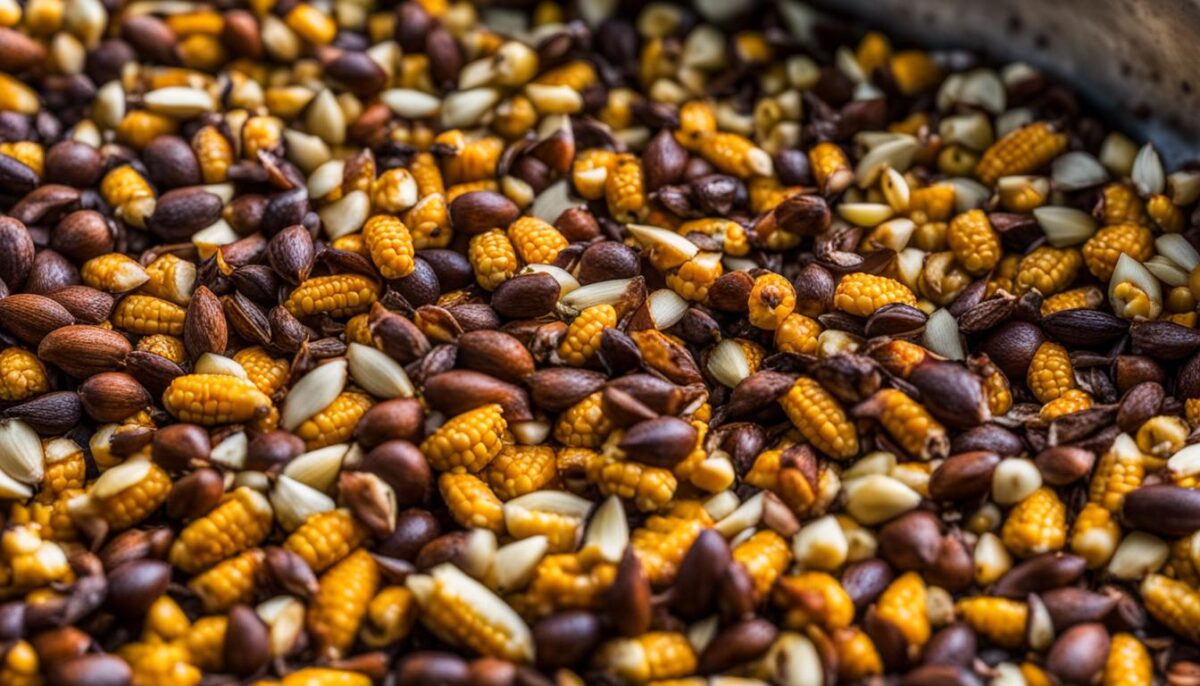
Exploring Chicken Anatomy
Understanding the anatomy of chickens is crucial for their care. Let’s take a closer look at some key anatomical features:
Wattle:
The wattle is the flesh under a chicken’s beak and serves as a heat-regulating mechanism. It contains blood vessels that help cool the chicken down in warm weather.
Crop:
The crop is part of the digestive system that stores food before it is fully digested. It’s a pouch-like structure located at the base of the chicken’s neck, where food is temporarily held and softened before moving to the stomach.
Cloaca:
The cloaca serves as the reproductive and excretory opening for chickens. It is through the cloaca or vent that waste (feces) and eggs are expelled.
Spurs:
Spurs are sharp appendages that can grow on the legs of chickens. They are more commonly found on roosters and can be used for protection and dominance during fights.
Comb:
The comb is a featherless crest at the top of a chicken’s head. It varies in size, shape, and color among different chicken breeds. The comb helps regulate body temperature and can also serve as an indicator of overall health.
Vent:
The vent is the opening through which waste and eggs are expelled. It is also known as the cloaca and serves as both the reproductive and excretory opening for chickens.
Crest:
The crest refers to the feathers protruding from the top of a chicken’s head. Some breeds, such as Polish chickens, have large and elaborate crests, while others may have smaller or no crests at all.
| Anatomical Feature | Description |
|---|---|
| Wattle | The flesh under a chicken’s beak that helps regulate body temperature. |
| Crop | A pouch-like structure in the digestive system that stores and softens food. |
| Cloaca | The reproductive and excretory opening for chickens, also known as the vent. |
| Spurs | Sharp appendages that can grow on the legs of chickens, more commonly found in roosters. |
| Comb | A featherless crest on top of a chicken’s head that helps regulate body temperature. |
| Vent | The opening through which waste and eggs are expelled. |
| Crest | The feathers protruding from the top of a chicken’s head. |
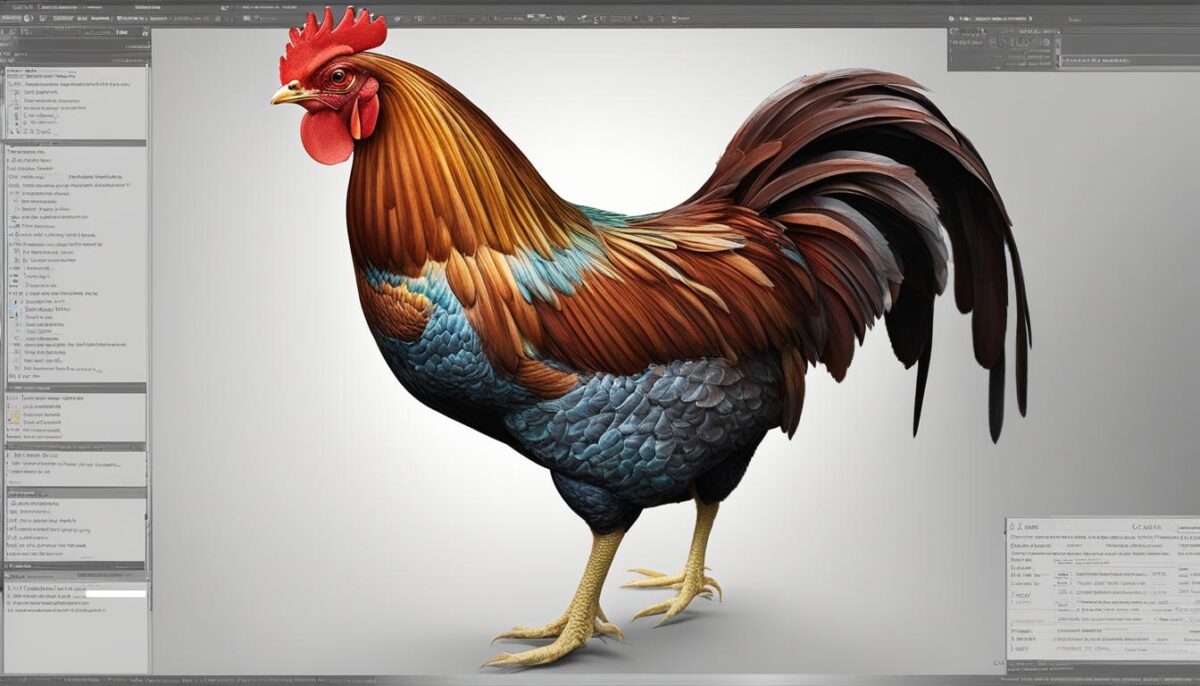
Understanding the anatomy of chickens is vital for their overall well-being. By familiarizing ourselves with their wattle, crop, cloaca, spurs, comb, vent, and crest, we can better monitor their health, detect potential issues, and provide appropriate care. Remember to observe your chickens regularly and seek veterinary assistance if you notice any abnormalities or signs of discomfort.
Understanding Chicken Reproduction
Reproduction is a natural part of a chicken’s life cycle. A broody hen is one that has decided to sit on and hatch a clutch of eggs. The bloom is a thin coating on the egg that prevents bacteria from affecting it. Candle refers to the process of shining a light on the backside of an egg to examine its contents. The internal pip occurs when a chick breaches the membrane into the air cell of the egg during the hatching process. The external pip is the first small crack or hole that a chick makes in the eggshell during hatching. A clutch is a group of eggs gathered for hatching. The blastoderm is a small white bullseye on the egg yolk that indicates a fertile egg, while a blastodisc indicates an infertile egg. An incubator is a machine used to maintain optimal temperatures for hatching eggs.
| Term | Definition |
|---|---|
| Broody | A hen that has decided to sit on and hatch a clutch of eggs. |
| Bloom | A thin coating on the egg that prevents bacteria from affecting it. |
| Candle | The process of shining a light on the backside of an egg to examine its contents. |
| Internal Pip | The moment when a chick breaches the membrane into the air cell of the egg during the hatching process. |
| External Pip | The first small crack or hole that a chick makes in the eggshell during hatching. |
| Clutch | A group of eggs gathered for hatching. |
| Blastoderm | A small white bullseye on the egg yolk that indicates a fertile egg. |
| Blastodisc | An infertile egg without a visible blastoderm. |
| Incubator | A machine used to maintain optimal temperatures for hatching eggs. |
“The miracle of life unfolds as a broody hen diligently sits on her clutch of eggs, waiting for the magic to happen. The bloom, a protective coating, keeps the eggs safe from harmful bacteria. To peer into the secrets of the egg, chicken keepers use the method of candle, where a light is shone on the egg to reveal its contents. As the chicks develop, the internal pip occurs when they break through the membrane and reach the air cell inside the egg. Then, with determination, they make the external pip, their first crack in the eggshell, signaling their imminent arrival. These fascinating processes can be further supported by using an incubator, a controlled environment that provides the perfect conditions for hatching.”
Understanding the intricate details of chicken reproduction allows chicken keepers to successfully hatch and raise healthy chicks. From the decision of a broody hen to care for a clutch of eggs to the various stages of development within the egg, each step is crucial to the hatching process. By utilizing techniques such as candle, breeders can monitor the progress and viability of the developing embryos. The use of an incubator provides a controlled environment that ensures optimal temperature and humidity levels, increasing the chances of successful hatching.
Table: Explanation of Key Terms Related to Chicken Reproduction
Exploring Chicken Behavior
Chickens exhibit fascinating behaviors that provide insights into their social dynamics and communication. One intriguing behavior is tidbitting, where a rooster drops food or treats at the feet of hens and then dances around excitedly. This behavior serves as a way to attract a mate and demonstrate the rooster’s ability to gather and provide resources for the flock. Tidbitting not only showcases the rooster’s fitness but also fosters social bonding within the flock.
Another interesting behavior in chickens is zipping, which occurs during the hatching process. When a baby chick is ready to hatch, it starts pecking at its shell, creating a ring-like pattern around it. This process weakens the shell, allowing the chick to break free. Zipping is an essential step in the hatching process and signifies the chick’s readiness to enter the world.
To better understand these behaviors and many others, it is essential for chicken owners to observe and learn from their flock. Paying attention to their actions and interactions can provide valuable insights into their well-being, social hierarchy, and overall health. By engaging with their chickens and observing their behavior closely, owners can establish strong bonds and ensure the happiness and welfare of their feathered friends.
Observing chickens’ behaviors is like unlocking a secret language that speaks volumes about their needs, desires, and interactions. Tidbitting and zipping are just two examples of the fascinating behaviors that make chickens such captivating creatures to study and appreciate.
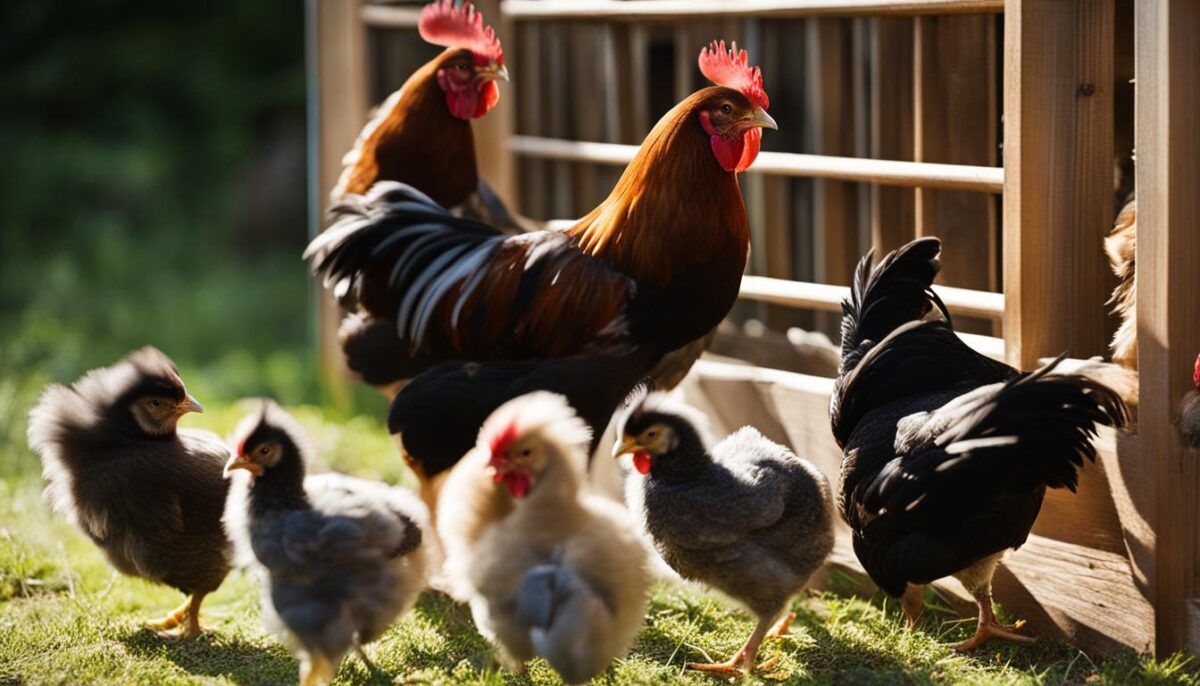
Table: Common Behaviors and Their Meanings
| Behavior | Meaning |
|---|---|
| Tidbitting | A rooster’s courtship behavior, offering food to attract mates |
| Zipping | The process of a baby chick breaking free from its shell during hatching |
| Dust Bathing | A method of grooming and keeping feathers clean by rolling in dust or loose soil |
| Wing Spreading | A sign of dominance or aggression displayed by spreading and flapping wings |
| Pecking Order | The hierarchical social structure within a flock, established through pecking and displays of dominance |
Understanding and appreciating chicken behavior not only enhances the bond between owners and their feathered companions but also enables better care and welfare. By providing an enriched environment that allows for natural behaviors and social interactions, chicken owners can create a fulfilling and stress-free life for their flock.
Understanding Chicken Keeping
Proper chicken keeping involves certain practices that contribute to the well-being of the flock. Culling is an important aspect of chicken keeping, which involves identifying and removing non-laying or diseased birds from the flock. This practice helps maintain a healthy population and prevents the spread of diseases. Biosecurity is another critical measure in chicken keeping, aimed at protecting backyard chickens from infectious diseases and ensuring their overall health and safety.
Culling is the process of carefully evaluating each bird in the flock to determine their productivity and health status. Non-laying hens or roosters that are not contributing to breeding programs or the overall well-being of the flock may need to be culled. This practice helps manage the flock’s resources more efficiently and maintain a sustainable population. Culling can also be necessary when dealing with diseased birds to prevent the transmission of illnesses to the rest of the flock.
“Culling is an essential practice in chicken keeping, ensuring the overall health and productivity of the flock.”
Biosecurity plays a crucial role in preventing the introduction and spread of infectious diseases among backyard chickens. It involves implementing measures to minimize the risk of disease transmission, such as controlling access to the chicken coop, limiting contact with other flocks, and practicing proper hygiene protocols. Biosecurity measures can include regular cleaning and disinfection of the coop, quarantining new birds before introducing them to the flock, and monitoring the flock’s health regularly.
| Chicken Keeping Practices | Description |
|---|---|
| Culling | The process of removing non-laying or diseased birds from the flock to maintain a healthy population and prevent the spread of diseases. |
| Biosecurity | Measures taken to protect backyard chickens from infectious diseases, including controlling access to the coop and implementing hygiene protocols. |
By practicing culling and implementing biosecurity measures, chicken keepers can ensure the overall health, productivity, and well-being of their flock. These practices contribute to a sustainable and thriving chicken-keeping experience while minimizing the risk of disease outbreaks and maintaining the highest standards of animal welfare.
Exploring the Unique Respiratory System of Birds
Birds have a fascinating respiratory system that sets them apart from mammals. Unlike mammals, which have lungs with tiny alveoli for gas exchange, birds have a more efficient system that involves air sacs. These air sacs keep their lungs perpetually inflated, allowing for a continuous flow of oxygen-rich air. This unique adaptation enables birds to have a higher metabolic rate and supports their incredible flight abilities.
In birds, the respiratory system takes up around 20% of their total volume, compared to just 5% in mammals. The air sacs act as bellows, drawing fresh air into the lungs and ensuring efficient gas exchange. As the bird breathes in, air flows through the posterior air sacs, then through the lungs, and finally into the anterior air sacs. This unidirectional flow of air allows for a constant supply of oxygen to the bird’s body.
The lungs of birds are tubular and differ from the spongy lungs of mammals. The avian lungs have small air capillaries that run parallel to blood capillaries, maximizing the surface area for gas exchange. This efficient design ensures that oxygen from the inhaled air is quickly absorbed into the bloodstream, while carbon dioxide is efficiently expelled during exhalation. The constant airflow and efficient oxygen exchange in birds’ lungs support their high energy demands, especially during activities like flying.
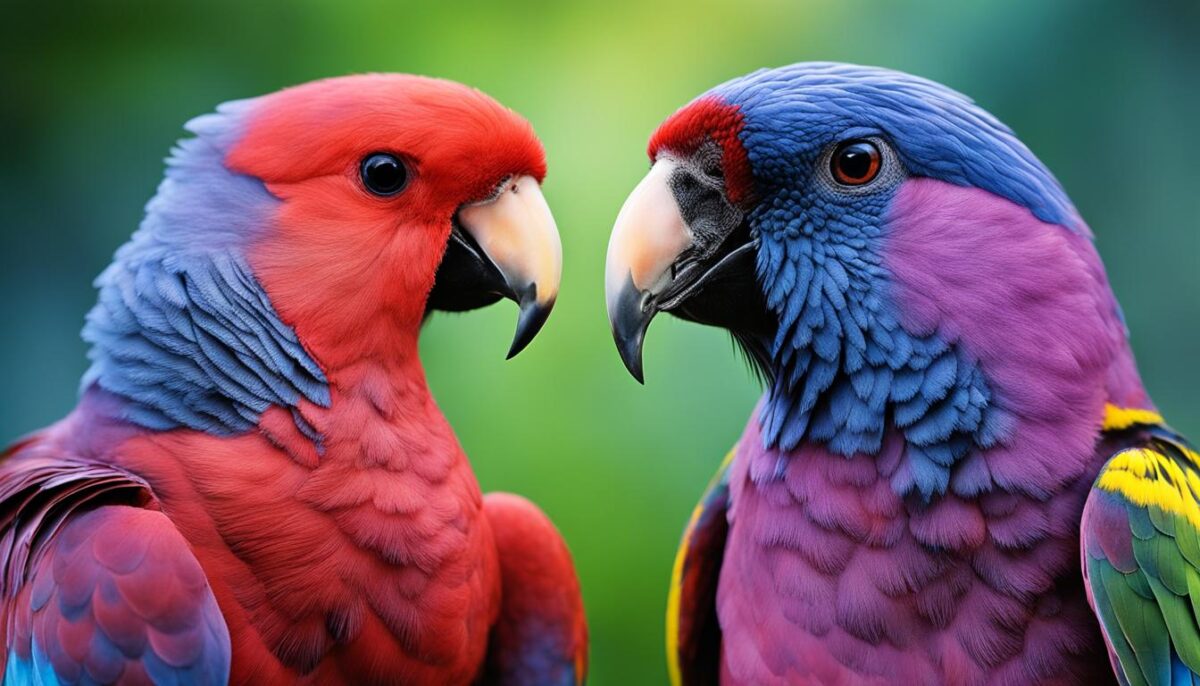
The Role of Air Sacs
The air sacs in birds play a crucial role in respiration. In addition to maintaining lung inflation, they also aid in thermoregulation and vocalization. The air sacs help cool or warm the body by adjusting the temperature of the air flowing through them. In some bird species, such as songbirds, the air sacs are involved in producing complex vocalizations, enabling birds to create a wide range of melodic sounds.
Just as the unique respiratory system of birds enables their incredible flight capabilities, it also serves as a reminder of nature’s diverse adaptations to different environments and lifestyles. Take a moment to appreciate the intricate design and efficiency of avian respiration, a testament to the wonders of the natural world.
Conclusion
Understanding the anatomy of chickens is crucial for chicken owners. One important aspect of their anatomy is their rear end or “butt.” Chickens have a vent, also known as the cloaca, which serves as both the reproductive opening and the excremental escape hatch. Through the vent, chickens expel waste and eggs, making it an essential part of their digestive system.
Monitoring the health of a chicken’s vent is vital for their overall well-being. Issues such as pasty butt can arise, causing blockage and preventing the passage of stool. It’s important to take prompt action if any problems with the vent are observed to ensure the chicken’s health and comfort.
In addition to understanding chicken anatomy, providing a suitable environment, proper nutrition, and monitoring chicken behavior and health are essential aspects of responsible chicken keeping. By creating a comfortable and safe living space for chickens, feeding them a balanced diet, and being attentive to any signs of illness or distress, chicken owners can ensure the overall well-being of their flock.
Furthermore, birds, including chickens, have a unique respiratory system that contributes to their high metabolic rate and flight abilities. Their respiratory system includes air sacs and tubular lungs, allowing for efficient breathing and gas exchange. This specialized system is adapted to meet the specific needs of birds and plays a crucial role in their overall health and vitality.
FAQ
Do chickens have a posterior or “butt”?
Yes, chickens have an anatomical structure called the vent, also known as the cloaca, which serves as both their reproductive opening and excremental escape hatch.
What is the vent and what is its function?
The vent is the opening through which chickens expel both feces and eggs. It is pink and moist in a healthy chicken.
What is pasty butt and how does it affect chickens?
Pasty butt is a condition that can occur in chicks, causing a blockage and preventing them from passing stool. It is important to monitor the health of a chicken’s vent to ensure their well-being.
What are the different stages of chicken development?
A newly hatched chicken is called a chick. A male chicken under a year old is called a cockerel, while a female chicken under a year old is called a pullet. Juvenile refers to a young male or female bird. A cock is a male chicken that is a year or older, and a hen is a female chicken that is a year or older. A rooster includes both cock and cockerel. Bantam is a term used to describe small breeds of chickens.
What are the different types of chicken breeds?
Layer breeds are primarily raised for egg collection, while dual-purpose breeds are raised for both eggs and meat. Ornamental breeds are raised primarily for show or exhibition purposes, and production breeds are raised for high egg or meat production.
What are the essential components of a chicken’s environment?
A nesting box is where chickens lay eggs privately. Bedding or litter covers the floor or ground in confined spaces, providing comfort and cleanliness. Hardware cloth and chicken wire are used to contain chickens within the coop. A brooder is a heated enclosure for raising chicks. Roosting refers to chickens resting on an elevated perch. A chicken tractor is a movable coop without a floor. A coop is an enclosure where chickens are kept safe and secure, and a run is an enclosed outdoor space for chickens to roam.
What are the different types of feathers on chickens?
Chickens have various types of feathers, including molting feathers that are lost and regrown seasonally. Frizzle feathers are genetically programmed ornamental feathers that curl. Down feathers cover young birds and are found beneath the exterior feathers of older birds. Muffs are short feathers on the sides of a chicken’s face and below the chin area. Saddle feathers are located in front of the tail, and sickle feathers are the long curving feathers on a rooster’s tail. Beards are elongated feathers below the beak, while pin feathers are developing feathers seen on maturing birds and after molting.
What are some common health issues in chickens?
Some common health issues in chickens include wry neck, mites, poultry lice, coccidiosis, avian influenza, fowl pox, Newcastle disease, salmonella, bumblefoot, mycoplasma, conjunctivitis, and paralysis.
What are the different types of chicken feed?
Starter grower feed is for growing chicks up to laying age, layer feed supports healthy egg production in hens, all flock feed is formulated for mixed flocks, gamebird showbird feed promotes growth in gamebirds, showbirds, and meatbirds, scratch is a blend of unfortified grains, and grit aids in the breakdown of food in a chicken’s gizzard.
What are the notable anatomical features of chickens?
Chickens have wattles, which are flesh under their beaks and serve as a heat-regulating mechanism. They also have a crop, which is part of the digestive system that stores food before it is fully digested. The vent is the reproductive and excretory opening, and spurs are sharp appendages that can grow on their legs. The comb is a featherless crest on top of their heads, and the crest refers to the feathers protruding from the top of their heads.
How do chickens reproduce?
A broody hen is one that has decided to sit on and hatch a clutch of eggs. The bloom is a thin coating on the egg that prevents bacteria from affecting it. Candle refers to the process of shining a light on the backside of an egg to examine its contents. The internal pip occurs when a chick breaches the membrane into the air cell during hatching, while the external pip is the first small crack or hole made by a chick in the eggshell. A clutch is a group of eggs gathered for hatching, and the blastoderm or blastodisc indicates whether an egg is fertile or infertile. An incubator is a machine used to maintain optimal temperatures for hatching eggs.
What are some unique behaviors of chickens?
Tidbitting is when a rooster drops food or treats at the feet of hens and then dances around excitedly in an attempt to attract a mate. Zipping occurs when a baby chick pecks at its shell, creating a ring around it to enable its escape.
What are some important practices for chicken keeping?
Culling is the process of identifying and removing non-laying or diseased birds. Biosecurity involves implementing measures to protect backyard chickens from infectious diseases and prevent their spread.
How does the respiratory system of birds differ from mammals?
Birds have a unique respiratory system that includes air sacs, which keep their lungs perpetually inflated. This system is more efficient than the lung structure of mammals, as it takes up 20% of a bird’s volume compared to 5% in mammals. Air flows through the air sacs and into the tubular lungs, allowing for efficient gas exchange.


